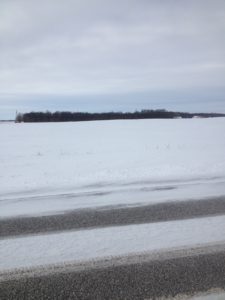
Land to be restored and converted
It is hard to imagine the potential impact of a piece of bare ground in the wintertime. That potential is hidden, waiting for a little encouragement both from the weather and from the people who own and manage it. This time of year, our land management team (two of our staff and our Property Committee) spend a lot of time thinking about that.
This year is an exciting one in that regard because many seeds have already been planted, literally, toward improving more than 50 acres of our property for beneficial insects, with dozens more to be planted in 2017. Acres of forest and shrubland have been and will continue to be improved for wildlife within and around our existing preserves. We now have the opportunity for expanding that even further. We recently received a donation of 60 acres of land along Woodland Drive – land that was at one time forested wetland, was artificially drained and converted to farmland. It’s not that there’s a problem with it being farmland- we and our animals need to eat, after all; however, this land lies along the migration routes for millions of animals along Lake Michigan. At one time it supported those migrations. People utilized the land in ways to contribute to our economy – which it did very well for many years. Most recently it has been planted in soybeans, and this year it will likely be farmed in order to keep weeds down while we prepare for restoration. This land has done it’s part for us. Now, it is our intention to give something back to it.
Wildlife has lost a lot of land along the coasts of the Great Lakes. About a third of the songbirds that migrate through our region are decreasing in numbers each year. That’s not a good thing for the birds, and probably not a good indicator for our own health. Patches of habitat near the shore are precious to nature, so the acquisition of this property is very important to us and to the wildlife that shares our space.
We’re very grateful for the donation that made this project possible. We’re already working with experts in the field of restoration and applying for funding to restore the onsite wetland. This area will be open to the public for hiking and nature-watching as trails and a parking area are developed. At the same time, it will be a refuge for native plants and both migratory and resident wildlife. It will take years and much work to restore, but in time native plants will call this place home. The soil and all that lives within it will heal, and many forms of life will benefit, including our own species. This project in itself will make 2017 a great year for those of us who care about the nature of our Lakeshore.
photo: property as it is today
